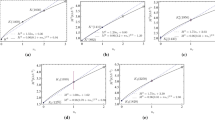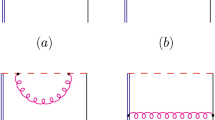Abstract
We calculate the time reversal odd (T-odd) generalized transverse momentum-dependent parton distributions (GTMDs) \(F^o_{1,2}\) and \(H^o_{1,1}\) and the corresponding Wigner distributions in a light-front quark–diquark model based on AdS/QCD. In the limit of zero momentum transfer, these reduce to the Sivers and Boer–Mulders TMDs, respectively. We have incorporated both scalar and axial vector diquarks in the model and obtained an overlap representation of the GTMDs using the light-front wave functions (LFWFs). Contribution from the final state interaction is incorporated at the level of one gluon exchange as a phase factor in the LFWF. We show that the final state interaction term can be factored out in this model and this part is the same for both GTMDs. We also present the Sivers and Boer–Mulders Wigner distributions in transverse momentum plane as well as in transverse impact parameter plane.





Similar content being viewed by others
References
P. Hagler, A. Mukherjee, A. Schafer, Phys. Lett. B 582, 55 (2004)
S. Meissner, A. Metz, M. Schlegel, JHEP 0908, 056 (2009)
C. Lorce, B. Pasquin, M. Vanderhaeghen, JHEP 05, 041 (2011)
C. Lorc, B. Pasquini, JHEP 1309, 138 (2013)
E.P. Wigner, Phys. Rev. 40, 749 (1932)
X d Ji, Phys. Rev. Lett. 91, 062001 (2003)
A .V. Belitsky, X d Ji, F. Yuan, Phys. Rev. D 69, 074014 (2004)
C. Lorce, B. Pasquini, Phys. Rev. D 84, 014015 (2011)
Y. Hagiwara, Y. Hatta, Nucl. Phys. A 940, 158 (2015)
Y. Hatta, Y. Hagiwara, EPJ Web Conf. 112, 01010 (2016)
C. Lorce, B. Pasquini, X. Xiong, F. Yuan, Phys. Rev. D 85, 114006 (2012)
Y. Hatta, Phys. Lett. B 708, 186 (2012)
T. Liu, B.Q. Ma, Phys. Rev. D 91, 034019 (2015)
Y. Hagiwara, Y. Hatta, T. Ueda, Phys. Rev. D 94(9), 094036 (2016)
D. Chakrabarti, T. Maji, C. Mondal, A. Mukherjee, Phys. Rev. D 95(7), 074028 (2017)
A. Mukherjee, S. Nair, V.K. Ojha, Phys. Rev. D 90(1), 014024 (2014)
A. Mukherjee, S. Nair, V.K. Ojha, Phys. Rev. D 91(5), 054018 (2015)
J. More, A. Mukherjee, S. Nair, Phys. Rev. D 95(7), 074039 (2017)
J. More, A. Mukherjee, S. Nair, Eur. Phys. J. C 78(5), 389 (2018)
J. Zhou, Phys. Rev. D 94(11), 114017 (2016)
C. Lorc, B. Pasquini, Phys. Rev. D 93(3), 034040 (2016)
M.G. Echevarria, A. Idilbi, K. Kanazawa, C. Lorc, A. Metz, B. Pasquini, M. Schlegel, Phys. Lett. B 759, 336 (2016)
Z.L. Ma, Z. Lu, Phys. Rev. D 98(5), 054024 (2018)
T. Maji, C. Mondal, D. Chakrabarti, Phys. Rev. D 96(1), 013006 (2017)
S.J. Brodsky, D.S. Hwang, I. Schmidt, Phys. Lett. B 530, 99 (2002)
S.J. Brodsky, B. Pasquini, B.W. Xiao, F. Yuan, Phys. Lett. B 687, 327 (2010)
N. Kumar, H. Dahiya, Eur. Phys. J. A 51(4), 51 (2015)
T. Maji, D. Chakrabarti, A. Mukherjee, Phys. Rev. D 97(1), 014016 (2018)
M. Burkardt, Phys. Rev. D 66, 114005 (2002)
R. Jakob, P.J. Mulders, J. Rodrigues, Nucl. Phys. A 626, 937 (1997)
A. Bacchetta, F. Conti, M. Radici, Phys. Rev. D 78, 074010 (2008)
T. Maji, D. Chakrabarti, Phys. Rev. D 94(9), 094020 (2016)
J.R. Ellis, D.S. Hwang, A. Kotzinian, Phys. Rev. D 80, 074033 (2009)
D.S. Hwang, J. Korean Phys. Soc. 62, 581 (2013)
T. Maji, D. Chakrabarti, Phys. Rev. D 95(7), 074009 (2017)
T. Maji, D. Chakrabarti, O.V. Teryaev, Phys. Rev. D 96(11), 114023 (2017)
D. Chakrabarti, C. Mondal, Phys. Rev. D 88(7), 073006 (2013)
M. Burkardt, D.S. Hwang, Phys. Rev. D 69, 074032 (2004)
Z. Lu, I. Schmidt, Phys. Rev. D 75, 073008 (2007)
B. Pasquini, S. Rodini, A. Bacchetta,. arXiv:1907.06960 [hep-ph]
D. Boer, P.J. Mulders, F. Pijlman, Nucl. Phys. B 667, 201 (2003)
Acknowledgements
We thank Cedric Lorce for fruitful discussions. The work of T.M. is supported by the National Natural Science Foundation of China (NSFC) through Grant No. 11875112 and the China Postdoctoral Science Foundation through Grant No. KLH1512104.
Author information
Authors and Affiliations
Corresponding author
Appendices
A Appendix: Other T-odd GTMDs
For completeness, we list our model results for other T-odd GTMDs here.
(A) \(\varGamma =\gamma ^+\):
(B) \(\varGamma =\gamma ^{+}\gamma ^5\):
(C) \(\varGamma =i\sigma ^{j+}\gamma ^5\):
All the above T-odd distributions have logarithmic divergence as the power divergent terms cancel out for the combinations \((D'_1-D'_2)\) and \((D''_1-D''_2)\). The logarithmic divergence comes from the gluon mass being set to zero, and a regulator is needed for numerical evaluations. At \(\varvec{\varDelta }_{\varvec{\perp }} = 0\) [2], these T-odd GTMDs do not have any TMD limit.
B Plots of T-odd GTMDs
Our model results for T-odd GTMDs \(F^o_{1,2} ({{\varvec{\Delta }}}_{\perp },\mathbf{p}_{\perp },x)\) is shown in Fig. 6 in the \(\mathbf{p}_{\perp }\) and \({{\varvec{\Delta }}}_{\perp }\) plane for different values of x. The three rows are for three different values of \(x=0.1,0.2\) and 0.5, and the first and second columns are for u and d quarks, respectively. One can notice that the \(F^o_{1,2}\) is mostly negative for u quark and positive side for d quark. The distributions become flat near (0, 0) with the increasing value of x.
Figure 7 shows the model result for \(H^o_{1,1} ({{\varvec{\Delta }}}_{\perp },\mathbf{p}_{\perp },x)\) for u and d quarks with a different values of \(x=0.1,0.2\) and 0.5. Here, distributions do not change sign for the change in flavor unlike \(F^o_{1,2} ({{\varvec{\Delta }}}_{\perp },\mathbf{p}_{\perp },x)\).
Rights and permissions
About this article
Cite this article
Chakrabarti, D., Kumar, N., Maji, T. et al. Sivers and Boer–Mulders GTMDs in light-front holographic quark–diquark model. Eur. Phys. J. Plus 135, 496 (2020). https://doi.org/10.1140/epjp/s13360-020-00470-0
Received:
Accepted:
Published:
DOI: https://doi.org/10.1140/epjp/s13360-020-00470-0






